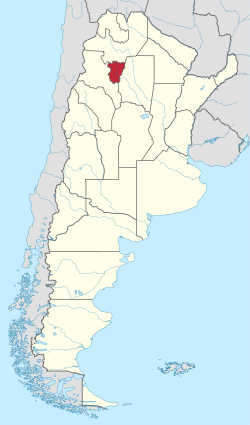| Province of Tucumán | |
 | |
Location  | |
Coat of arms and flag  | |
| State | Argentina |
|---|---|
| Capital | San Miguel de Tucumán |
| Surface | 22,524 km² |
| Inhabitants | 1.592.878 (2015 estimate), 673.307 (2010 census) |
| Institutional website | |
Province of Tucumán it is the smallest province argentina located in the Northwest Andes.
To know
The Province of Tucumán is nicknamed "El Jardín de la República" (the garden of the Republic).
Geographical notes
It borders the provinces Jump, Santiago del Estero is Catamarca.
In spite of its relative average territorial extension, it is necessary to distinguish two separate geographical realities of the province. The east with the plains of the Gran Chaco and the west which presents a mixture of Sierra delle Pampa to the south, and the canyons of northwestern Argentina to the north, with the high peak of Cerro del Bolsón with its 5,500 meters.
When to go
Warm sub-tropical temperatures pervade the entire region, but mountainous regions see twice as much rainfall as lowlands due to the effect of the mountains on warm winds from the Atlantic Ocean.
Background
Before the Spanish colonization of the Americas, the region was inhabited by the Diaghiti and Calchaqui, populations who practiced agriculture. In 1533 the explorer Diego de Almagro explored theArgentina northwest including Tucumán.
Tucumán was a transit center for the gold and silver convoys headed for the embarkations of the Viceroyalty of Peru, developing important activities related to breeding, textiles, and carpentry at the service of the convoys themselves along the way to Buenos Aires.
In 1812 the Argentine patriot general Manuel Belgrano won the Spaniards in the firm battle of Tucumán, decisive for the independence of Argentina.
On 9 July 1816 at the Congress of Tucumán le Provincias Unidas del Río de la Plata they declared their independence from Spain.
Spoken languages
In the province of Tucumán, people speak Spanish with an accent similar to that of other Argentine provinces (a mix of Italian, Spanish, and Creole "Gaucho" accents), but with some unique local words.
Territories and tourist destinations
Urban centers
- Amaicha del Valle - Small traditional village accessible via the Ruta Nacional 38 and the road 307, which still has the Indian population.
- San Miguel de Tucumán (or only Tucumán) - Capital of the province.
- Tafí Viejo - Founded by railway workers.
- Tafí del Valle - The largest tourist town in the Tafí Valley.
Other destinations
- Dique el Cadillal - Just north of San Miguel de Tucumán, is a dam that gives rise to a beautiful lake with many shops and restaurants.
- El Centro (literally "the center") - An area not far from San Miguel de Tucumán where most of the shops and businesses are located. To the west (towards the mountain) you pass Yerba Buena, which is a more residential area with high-class establishments. The top of the mountain is called San Javier, which features many scenic spots and trails, and elegant hotels. Be prepared for the cold as the temperature can drop a lot.
How to get
By plane
Teniente Benjamín Matienzo International Airport, which is 9km east of San Miguel de Tucumán, has 5 daily flights from Buenos Aires with Aerolíneas Argentinas and LAN, one daily flight from Mendoza, one from Rosary and two from Córdoba all with Sol Lineas Aereas. International flights are currently suspended, but Aerosur had four flights per week until 2010 Santa Cruz de la Sierra, in Bolivia, with direct links to Madrid is You love me.
On the train
Another choice is traveling by train, which departs twice a week from Buenos Aires stopping at Santiago del Estero is Rosary).
By bus
As in most places in Argentina, traveling to and from Tucumán can be done by bus from almost any city, and even from some cities in Bolivia or Peru.
How to get around
By car
Taxis are quite cheap and a great solution for foreigners who are unfamiliar with public transport routes and timetables.
By bus
City buses are fairly straightforward (around 40 lines) and as there are not many, they are fairly easy to use. The fixed price for urban sections (lines 1-19) is ARS 2 (November 2010), while it is higher for sections in the metropolitan area (lines 100-141).
What see
The main tourist section is just behind the central square. Government buildings, old houses and churches abound.
- Casa Historica - Two blocks south on Congress Street is the Casa Historica, where the Argentine Independence Act was signed. Inside, a small museum has artifacts from the colonial and revolutionary times.
- Nature - What is truly precious about the province of Tucumán is its nature, so much so that it is given the nickname "Garden of the Republic". It is the ideal place for those who love hiking, horseback riding or climbing. If one is brave enough to get off the beaten path, one should definitely enter the rainforest or reach the highest peaks. Unfortunately, the locals themselves are so unaware of their treasure that they find it difficult to recommend or promote it.
- La Ciudacita - If you have a week, it may be worth going to visit "La Ciudacita", the southern ruins of the Inca empire that you will hardly forget. Guides are also available.
What to do
The nightlife of the city of Tucumán is one of the liveliest in the whole country, particularly from Thursday to Sunday night. Thanks to an important university center, there is a huge community of young people.
At the table
Safety
Other projects
 Wikipedia contains an entry concerning Province of Tucumán
Wikipedia contains an entry concerning Province of Tucumán Commons contains images or other files on Province of Tucumán
Commons contains images or other files on Province of Tucumán
